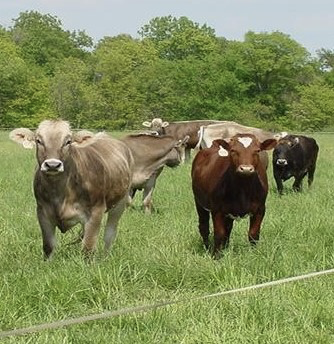
Less-than-optimum weather conditions, as well as the cost of fertilizer, fuel, and other production inputs are factors that often make it difficult for livestock producers to make a profit. Providing nutrition during times when pasture is not available is one of the costliest aspects of producing livestock, so it makes sense for producers to consider every option for minimizing the need for hay or other stored feed.
Stockpiling forage is the technique of allowing pasture growth to accumulate so that it can be grazed at a later time. This helps “even out” the availability of pasture forage, thus extending the grazing season while avoiding or minimizing the use of expensive haymaking machinery. Tall fescue is the forage species best suited to being stockpiled, mainly because it holds its forage quality well over a long period of time. However, forage of warm season grasses (WSG) such as bermudagrass and bahiagrass can also be stockpiled, which is worth considering by many livestock producers who have enough pasture acreage to allow them to use this approach.
Stockpiling WSG is not simply the practice of grazing excess late season growth; it requires planning and good management for optimum results. The first step is to reduce the stubble height to around two to three inches about 8 weeks before the expected date of the first killing frost. It is best to do this by grazing or by taking a late season cutting of hay. Next, 50 to 75 pounds (units) of nitrogen should be applied per acre, along with any other nutrients recommended by a soil test report. Then animals need to be excluded until a killing frost occurs or the forage is needed.
Grazing of stockpiled grass must be controlled, otherwise much of the forage will be wasted. Strip grazing is the most efficient technique. A good approach is to use an electric fence to allocate enough forage for about three days. Forage quality will decline over time, but initially should be on the order of 8 to 14% crude protein and at least 50% total digestible nutrients. It is important to not graze the stockpiled forage too closely, because the forage closest to the ground will be stemmy and low in quality, thus providing poor nutrition. A rule of thumb is to graze about two thirds of the height of the forage in a given allocation before providing access to additional stockpiled forage.
The amount of forage that can be stockpiled varies, but in a year with decent precipitation it could be 2,000 pounds or more of dry matter (DM) per acre. A 1,000 pound beef cow will consume about 26 pounds of DM per day. Thus, if 2,000 pounds of forage accumulate per acre and 65% is actually consumed, an acre would provide about 50 days of grazing for one 1,000 pound cow.
Stockpiling of WSG can work well for dry, mature beef cattle in a spring-calving herd, but supplementation may be needed for other cattle classes or other species of animals. Producers who have some tall fescue can graze stockpiled WSG before grazing fescue. In areas where cool season perennials are not adapted, stockpiled forage of WSG can provide late autumn/early winter nutrition that complements late winter-spring forage growth from other WSG pastures that have been overseeded with winter annuals.
In work done in Texas, stockpiled bermudagrass forage held its quality better than bahiagrass, but this technique can also work with bahiagrass. The variety ‘Tifton 85’ was the best of several bermudagrasses evaluated due to better autumn forage production and nutritive value.
_____________
Foraging Ahead is a column presented by Ragan and Massey and written by Dr. Don Ball, Professor Emeritus at Auburn University. Dr. Ball is one of the authors of the popular book “Southern Forages.”
